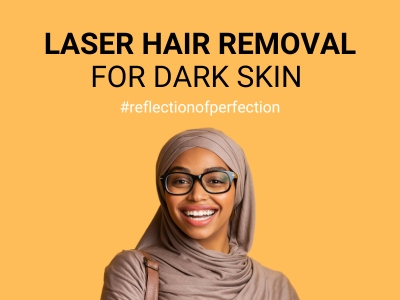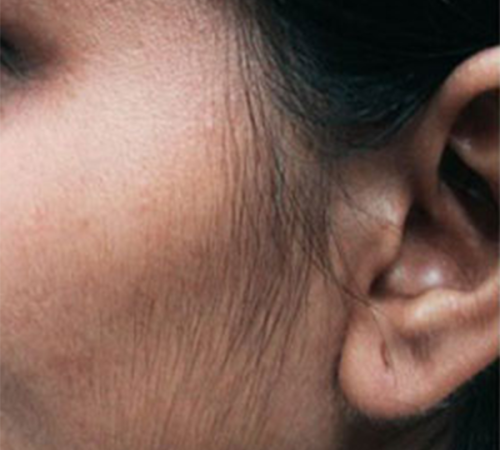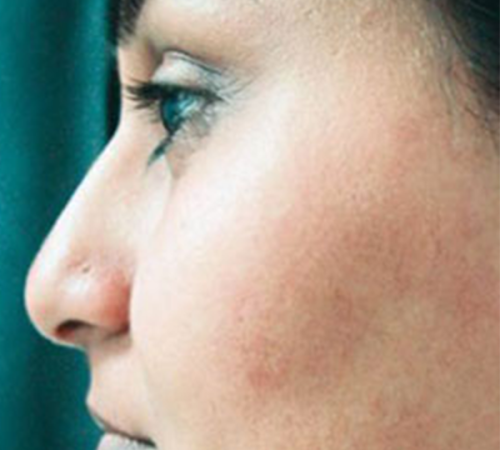
Laser Hair Removal For Dark Skin
Laser hair removal works by targeting the melanin in the hair follicle with laser light, this energy damages and goes on to destroy the hair follicle, thus stopping the follicle from producing further hairs. The newest lasers on the market now have the ability to target the melanin in the root of the hair without dispersing into the surrounding dark skin with its high melanin content allowing laser hair removal to work effectively on dark skin.
Dark skin and hair need to be treated slightly differently from Caucasian skin due to the high melanin content found in the skin. Unfortunately, because of this, it lagged behind in its ability to have lasers used on it, because lasers of the past picked up on the melanin in the skin and did not only hit the hair follicle.
This had unpleasant side effects and wasn’t workable. Luckily with advances in the laser industry, there are now lasers out there that can effectively and safely target only the hair follicle leaving your skin safe and sound.
There are a few different lasers available for darker skin but the one we use, and most recommend is the Soprano Titanium which has the Nd:Yag laser built in. This laser penetrates deeper into the skin picking up only on the hair and not the pigment in the skin, this is vital for darker skin as it allows you to miss the melanin and only hit the hair follicle.
Without this, you would see lighter patches where the melanin has been destroyed in the skin, definitely not what you want. With this advanced technology, you can safely receive laser hair removal with no risk to your skin.
At Dermaesthetics Clinic, we have been treating darker skin since these safe lasers came out on the market. We are very experienced and do understand any concerns you may have.
Come in for your free consultation and we can answer any questions you have. Meaning that you can get your treatments happy with the knowledge that you are in safe hands.
Laser hair removal works effectively for fine, thick or facial hair.

Our referral campaign offer is valid at all clinics for any treatment or package. All you need to do is book your free consultation to redeem. This applies to your friend too. Share this page with your friends and then enter the promo code, “FRIEND50” when booking your Free consultation. The offer is for packages £500 minimum spend. T & C’s apply.

Our E-Gift cards are a quick and easy way to treat someone special. Just complete our online form and choose the desired amount or service. You can email the E-Gift card directly to your chosen recipient or you can email it to yourself, print it out and give it to them personally.
Each Dermaesthetics Clinic Gift Card carries a monetary balance that can be used to purchase clinic treatments exclusively on www.dermasesthetics.uk
Your Gift Card balance will remain valid for twelve months after the date of purchase. The exact expiry date will be included in the Gift Card email itself. If you have added the card to an account, you will also be able to see when your balance is due to expire when you log in.
Gift Cards are valid for online bookings and eVoucher purchases made via www.dermaesthetics.uk Simply browse and book. Gift Cards can be used as full or part payment for all purchasable treatments and stays, but cannot be used to purchase more Gift Cards. If your treatment costs more than the value of the Gift Card, you can pay the additional amount at checkout. Similarly, if you don’t want to spend the whole gift at once, the remaining balance will stay in your account.
Gift Cards sent via email should arrive in your chosen inbox instantly. If your Gift Card does not arrive, please contact us via this form.
When purchasing electronic gift cards, you can choose the quantity you’re after and upon completion of your order you’ll receive both a confirmation email, and an additional email for each gift card, containing a unique code that you can forward on to your staff. If you’re looking to purchase 50 gift cards or more – leave the heavy lifting to us. Simply get in touch with us via this form to share the details of your purchase.
We offer a 14 day return policy on all gift cards, during which you can cancel your purchase, provided it hasn’t yet been added to a used. So if you have accidentally purchased too many Gift Cards or would like to cancel your order, please get in touch with our Customer Experience team via this form
Each Dermaesthetics Clinic Gift Card carries a monetary balance that can be used to purchase clinic treatments exclusively on www.dermasesthetics.uk
Your Gift Card balance will remain valid for twelve months after the date of purchase. The exact expiry date will be included in the Gift Card email itself. If you have added the card to an account, you will also be able to see when your balance is due to expire when you log in.
Gift Cards are valid for online bookings and eVoucher purchases made via www.dermaesthetics.uk Simply browse and book. Gift Cards can be used as full or part payment for all purchasable treatments and stays, but cannot be used to purchase more Gift Cards. If your treatment costs more than the value of the Gift Card, you can pay the additional amount at checkout. Similarly, if you don’t want to spend the whole gift at once, the remaining balance will stay in your account.
Gift Cards sent via email should arrive in your chosen inbox instantly. If your Gift Card does not arrive, please contact us via this form.
When purchasing electronic gift cards, you can choose the quantity you’re after and upon completion of your order you’ll receive both a confirmation email, and an additional email for each gift card, containing a unique code that you can forward on to your staff. If you’re looking to purchase 50 gift cards or more – leave the heavy lifting to us. Simply get in touch with us via this form to share the details of your purchase.
We offer a 14 day return policy on all gift cards, during which you can cancel your purchase, provided it hasn’t yet been added to a used. So if you have accidentally purchased too many Gift Cards or would like to cancel your order, please get in touch with our Customer Experience team via this form
The Soprano Titanium Laser hair removal method is unlike any other laser hair removal treatment. Featuring its exclusive 3D technology, Soprano Titanium combines the three most effective laser wavelengths into a single applicator, simultaneously targeting different tissue depths and anatomical structures within the hair follicle.
By combining the absorption and penetration levels of different wavelengths, along with extended treatment coverage, increased comfort and low maintenance requirements, Soprano Titanium is the safest and most efficient hair removal treatment available today.
A consultation is important to primarily discuss your needs and expectations. Our aesthetic practitioner will assess your medical history and suitability for the treatment and ask you to give informed consent for the treatment course.
A patch test is required at least 24 hours before commencing your first treatment. This is to assess the amount of melanin (colour) in the hair and determine the correct settings to use for an effective, virtually pain-free treatment. You will be asked to shave the area on the morning of your first treatment to achieve the best results.
During the treatment, the laser is passed over the skin in a slow, fluid motion. This movement gradually heats the hair follicles in the sub dermal (lower) layer of the skin using pulses of energy that are absorbed into the melanin (brown colour) in the hair. This stops the blood supply to the hair, so it can no longer be produced. All you will feel is a warm, comfortable sensation whilst this magic is happening!
After your treatment, your hair will start to grow as though it’s been shaved. The hairs can remain in the skin and often become attached to the epidermis (upper layers of skin). They will fall out within 19 to 30 days after the treatment as the skin naturally renews itself. As the blood supply to the hair has been stopped, the follicle starts to miniaturises, resulting in the hair being eradicated or depigmented and fined to vellus hair. Treatment intervals vary from 4-8 weeks apart depending on the treatment area.


Delve into our carefully selected showcase of before-and-after images, highlighting the extraordinary effects of Dermaesthetics Clinic treatments. Each photograph captures the skill and precision that embody our commitment to skin and body care artistry. Experience the allure of dramatic change and allow these visual stories to guide you through the possibilities of skin and body rejuvenation.
The Titanium Soprano laser hair removal system is a state-of-the-art solution offered at Dermaesthetics Clinic for those seeking smoother skin. It harnesses a blend of diode and Alexandrite lasers to emit a targeted wavelength of light, honing in on the melanin within hair follicles. As the melanin absorbs this laser energy, it heats and damages the follicle, leading to reduced hair growth over time.
Absolutely! The Titanium Soprano at Dermaesthetics Clinic is renowned for its ability to safely and effectively treat a spectrum of skin tones, embracing both tanned and darker skin. This versatility makes it a sought-after option for individuals with diverse skin types seeking laser hair removal solutions.
The journey towards permanent hair reduction is personalised. Generally, most patrons find that 6-8 sessions of Titanium Soprano laser hair removal, spaced about 4-8 weeks apart, deliver the desired long-lasting results. Your personalised treatment plan will be crafted during your consultation at Dermaesthetics Clinic.
The side effects are usually minimal and transient, encompassing redness and slight swelling at the treated zone. These tend to dissipate within a few hours to a couple of days. Adhering to our post-treatment care guidelines at Dermaesthetics Clinic will aid in minimising any potential side effects.
Most clients describe the Titanium Soprano laser hair removal at Dermaesthetics Clinic as less discomforting compared to other methods. Its integrated cooling system enhances comfort during treatment. Moreover, applying a topical numbing cream beforehand can further alleviate any potential discomfort.
Preparing for your Titanium Soprano session at Dermaesthetics Clinic involves avoiding sun exposure and tanning to avert skin damage. Shaving the treatment area a day prior ensures effective laser targeting at the hair follicles. It’s also advisable to refrain from using self-tanning products or creams on the target area.
Opting for Titanium Soprano laser hair removal at Dermaesthetics Clinic is an investment towards enduring hair reduction. Although the initial cost may surpass that of waxing or shaving, its ability to significantly reduce hair growth over time encapsulates both a time-saving and cost-effective solution in the long run.
Post-treatment care is paramount to a smooth recovery. Avoiding sun exposure and applying sunscreen is crucial to protect the treated area. It’s also advisable to avoid hot showers, saunas, and strenuous exercises for a few days post-session to mitigate the risk of skin irritation.
Scheduling your Titanium Soprano laser hair removal consultation or session at Dermaesthetics Clinic is straight forward. Simply reach out through our website or contact the clinic directly via phone. Our dedicated team is on hand to provide more information, address your queries, and assist in booking an appointment tailored to your needs.
Absolutely! The Titanium Soprano laser hair removal system at Dermaesthetics Clinic is engineered with cutting-edge technology, making it safe and effective for individuals with dark skin. By employing a combination of diode and Alexandrite lasers, it’s adept at treating a wide spectrum of skin tones, including dark skin, making smooth skin attainable for everyone.
Indeed, while the Titanium Soprano system at Dermaesthetics Clinic is well-suited for dark skin, it’s vital to consult with our skilled practitioners who are proficient with this technology. They can fine-tune the settings to ensure the safest and most effective treatment for dark skin, minimising the risk of pigmentation changes.
The journey towards hair reduction is tailored to each individual. Generally, irrespective of skin type, most individuals require 6-8 sessions of Titanium Soprano laser hair removal at Dermaesthetics Clinic, spaced approximately 4-8 weeks apart, to achieve the desired long-lasting results.
Side effects for individuals with dark skin are akin to those with lighter skin, typically mild and temporary. Common reactions include redness and mild swelling at the treatment site, which usually subside within a few hours to a couple of days.
The comfort-centric design of the Titanium Soprano system at Dermaesthetics Clinic makes it a preferred choice for individuals with dark skin. Its integrated cooling system alleviates discomfort during treatment. For those seeking additional comfort, a topical numbing cream can be applied before the procedure to further ease any discomfort.
Pre-treatment preparation for dark skin mirrors that for other skin types. It’s essential to avoid sun exposure and tanning to prevent skin damage. Shaving the treatment area a day prior to your session at Dermaesthetics Clinic ensures effective laser targeting. It’s also advisable to avoid using self-tanning products on the treatment area.
Post-treatment care for dark skin entails avoiding sun exposure and applying sunscreen to shield the treated area. It’s also prudent to avoid hot showers, saunas, and strenuous exercises for a few days post-session at Dermaesthetics Clinic to minimise the risk of skin irritation.
Scheduling a consultation or treatment session for Titanium Soprano laser hair removal at Dermaesthetics Clinic is a breeze. Individuals with dark skin can connect with us through our website or call the clinic directly. Our seasoned staff is available to provide additional information, answer any questions, and assist in booking an appointment tailored to their specific needs.
Get our latest special offers and news by email.
With over 10 years of experience in aesthetics and beauty, Dermaesthetics Clinic is a highly professional results driven clinic. We offer a wide range of skin care treatments and facial and body aesthetic procedures, using the latest technology available and advanced products. We have invested in high quality, regulated and proven specialist equipment to deliver safe, effective results.
With over 10 years of experience in aesthetics and beauty, Dermaesthetics Clinic is a highly professional results driven clinic. We offer a wide range of skin care treatments and facial and body aesthetic procedures, using the latest technology available and advanced products. We have invested in high quality, regulated and proven specialist equipment to deliver safe, effective results.